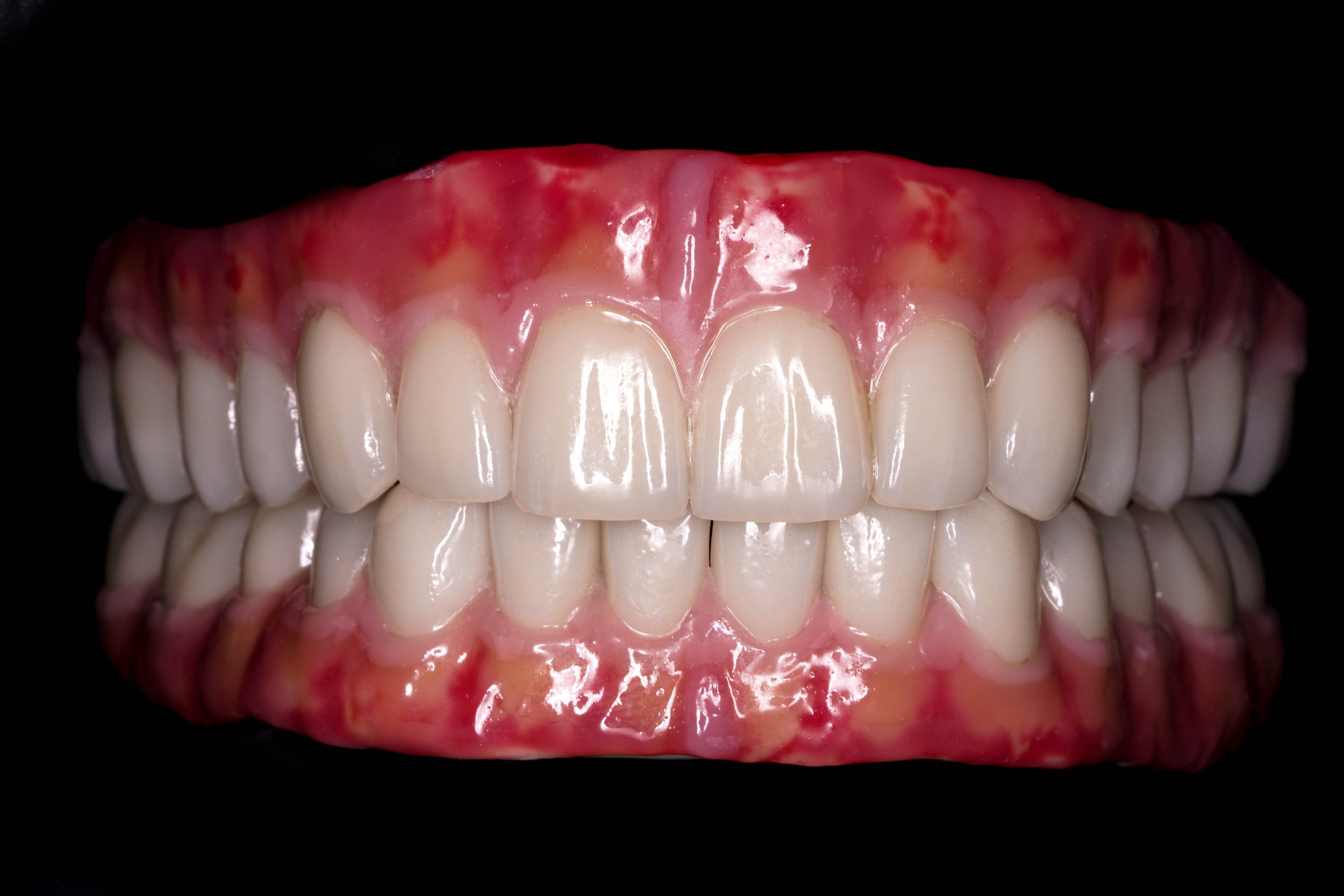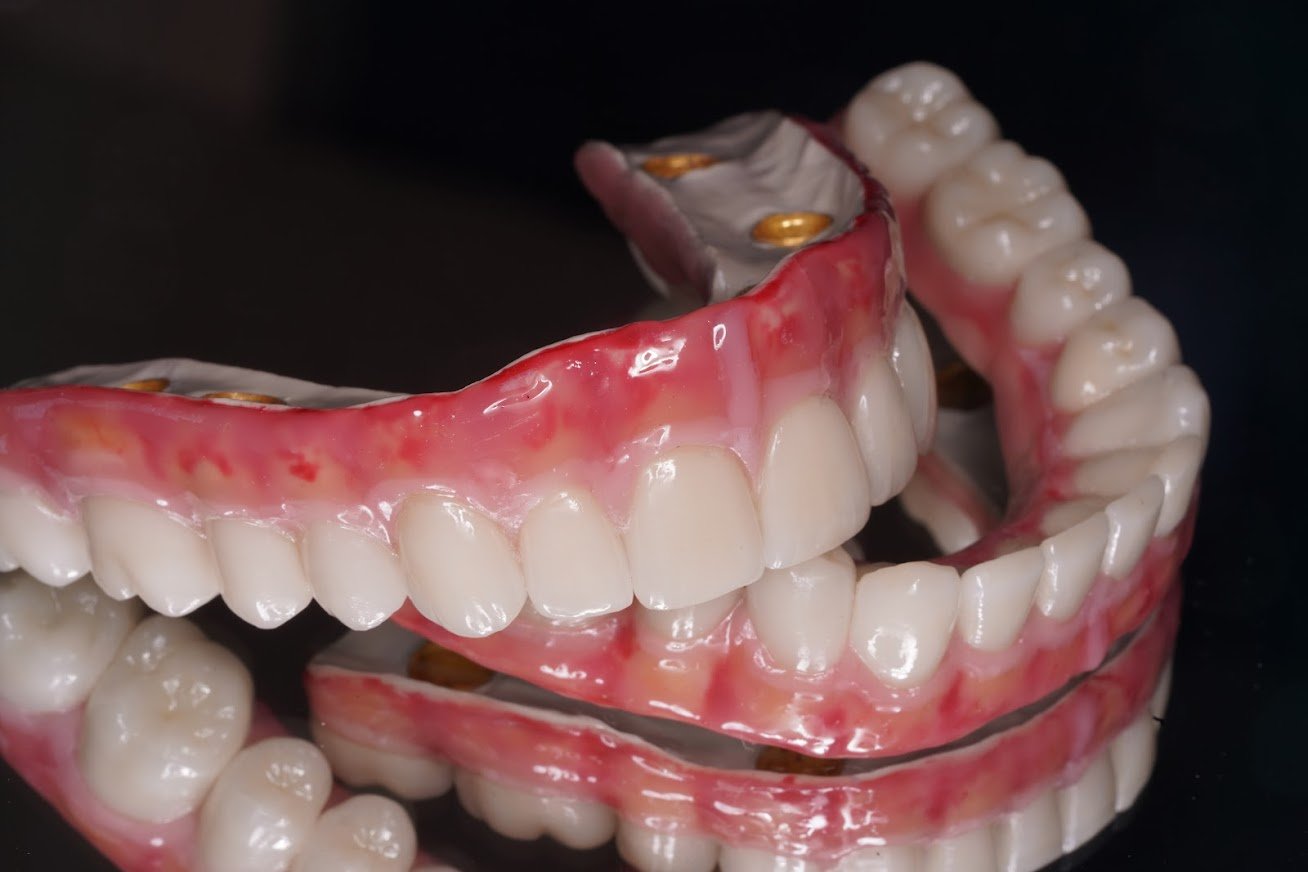For hundreds of years, dentures have been the only option when it comes to replacing a full mouth of teeth, with the earliest set dating back to 700 BC. While dentures do provide the patient with ‘teeth,” they are bulky, cover the roof of the mouth, can be easily dislodged when eating or drinking, and cannot typically be tolerated by patients with have a sensitive gag reflex. Thankfully, dental implants have dramatically improved the treatment options and outcomes for patients who are unable to keep their natural teeth.
There are numerous ways dental implants can be utilized in replacing missing teeth. Designer Dental offers a variety of options when considering implants to replace multiple teeth, but specifically we want to highlight a type of procedure called “All-On-X” (often times called All-On-4’s) or “implant supported” prosthesis.
All-On-X implant prosthetics almost completely eliminate the need to ever have something removable that comes in and out of the mouth. In an implant-supported prosthesis case, Dr. Nagao will extract all of the remaining teeth, smooth the bone, graft any necessary sites, and then place a number of implants in the jaw bone. Then, instead of using a traditional, removable denture, the patient receives a temporary set of teeth completely attached to the implants that does not come in and out of the mouth. These are held in by very small screws that engage with the implants. After a healing period, the temporary set of teeth is removed and a permanent set is fabricated. This permanent set can be made from a number of different materials, but the strongest and most natural looking material is ceramic.
Below are some frequently asked questions regarding implant-supported dentures.
I’ve been told I’m going to lose all my teeth. What happens next?
Once a treatment plan has been decided on, the first step is to collect records. This involves a series of photos, a digital scan of your mouth, 3D radiographs, and deciding what shade or color the dentures should be. Our goal is to design a beautiful smile that people assume is real. Once the records appointment is finished, the information goes to a dental lab where they design the first temporary set of teeth that will be used on the day of surgery.
How painful is the surgery? Will I need to be off work for an extended period of time?
Many of our patients are surprised at how smooth the recovery process can be after surgery. Peak swelling is anywhere from 3-5 days post-op. There will be some tenderness, possible bruising of the face, and swelling but more often than not our patients are able to return to work after a few days of rest.
Will I be able to eat like normal after surgery?
For the first few days following surgery, patients will want to be on a liquid-only diet. Here are some ideas for a liquid diet:
Protein shakes
Broth
Milkshakes
Tea
Frozen yogurt
Ice cream
Coconut water
Cream soups
Once you are cleared from the liquid diet, you can work up to foods with a bit more consistency. The general rule of thumb is if it can be cut with a spoon, it is generally ok to eat.
Steamed veggies
Mashed potatoes
Oatmeal
Soft bread
Eggs
Cheese
Bananas
After about four months of healing, the permanent set of teeth is fabricated and delivered. At this point, a normal diet may be resumed. Patients in All-On-X implant dentures enjoy eating foods such as corn on the cob, ribs, steaks, nuts, and crackers.
How much does it cost to have an All-On-X procedure?
Because there are a number of different combinations of materials, numbers of implants, type of hardware, etc. it’s best to schedule a consultation with Dr. Nagao to determine what plan best suits your needs and budget.
If I don’t have teeth anymore, I don’t need to come in for cleanings and exams anymore, right?
Wrong! If anything, routine maintenance and prevention is more important than ever. Even though implants cannot decay, they can still fail. Poor home care, smoking and lack of proper hygiene can lead to gum and bone disease and ultimate failure of the implant(s). It can also be tricky to clean underneath an implant supported prosthesis. Your hygienist has special instruments that can clean underneath the prosthesis and around the implants. Patients are still seen every three to six months for a cleaning, and a panoramic x-ray is taken every year to ensure the surrounding bone and structures are healthy.
How long do implants last?
Studies show that with proper care, implants can last well over 20 years. The denture prosthesis itself can experience normal wear and tear, but it is not uncommon for the teeth to last at least 10 years. As with natural teeth, it is important to maintain proper home care, come in for routine visits, and avoid using teeth for things they shouldn’t be, such as opening bottles.
What happens if an implant fails?
Just like anything else in the body, nothing in dentistry is ever really permanent. The name All-On-4 means a prosthesis is supported by a minimum of four implants. While four implants can certainly get the job done, it’s risky in the event one fails because replacing and remaking a denture becomes costly and time-consuming. Dr. Nagao believes that adding a few more implants creates a more predictable outcome and insurance that in the event an implant fails, the prosthesis is still stable and no additional implants need to be placed.
I have been using traditional dentures for years now. Is it possible to add implants to an existing denture?
It is possible, depending on the amount of bone present. Over time, bone levels can drop if the teeth have been missing for quite some time. A CBCT, or 3D x-ray, will provide detailed information that Dr. Nagao will read to determine if there is enough bone to place implants.
There seem to be a lot of pros to an All-On-X. What are the cons?
As mentioned above, patients need to have adequate bone levels to be able to place implants. If there is not enough bone, sometimes grafting procedures can be done, but not in all instances, and extensive grafting can add significant cost to the treatment plan. The overall cost of doing an All-On-X procedure is also a significant investment.
How many All-On-X procedures has Dr. Nagao done? Should I see an oral surgeon instead?
Dr. Nagao has extensive experience with implants and All-On-X cases. In fact, he is part of the American Academy of Implant Dentistry and International Congress of Oral Implantologists. He also teaches dentists across the country how to place implants and perform more advanced surgical procedures such as the All-On-X at a training facility in Phoenix. Patients are welcome to see an oral surgeon if they feel more comfortable, but Dr. Nagao is able to perform every aspect of your All-On-X treatment plan in one office from start to finish. With a complete understanding of your dental background, health history, extensive training in IV sedation and oral surgery, and a close relationship with the lab technicians who design and fabricate the teeth, you can rest assured that you will be in good hands at Designer Dental.




